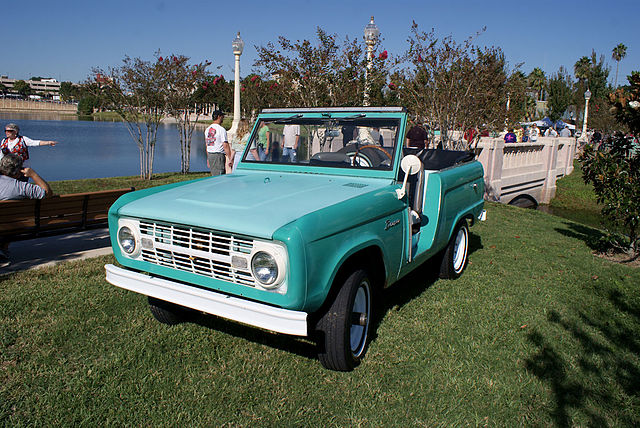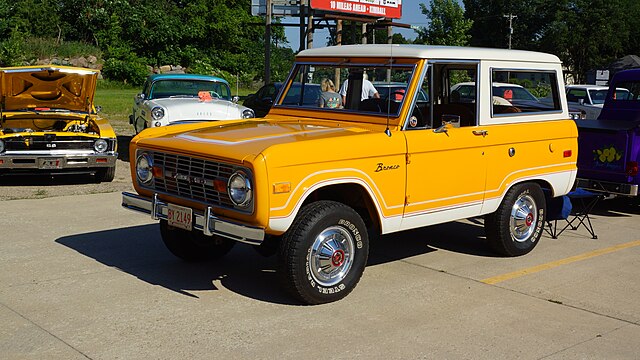
The Ford Bronco, first introduced in 1966, swiftly became a symbol of rugged individualism and adventure, marking its place in automotive history. With its unique blend of off-road capability and style, the first-generation Bronco (1966-1977) is celebrated for pioneering the compact SUV market, laying the groundwork for a legacy that continues to influence the automotive world.
This article delves into the key aspects of the first-generation Ford Bronco, exploring its design, performance, models, legacy, and resurgence.
Origins and Development

The Ford Bronco was conceived in the early 1960s as a response to the growing demand for off-road vehicles, epitomized by the success of the Jeep CJ-5 and the International Harvester Scout. Ford aimed to merge the ruggedness of a utility vehicle with the comfort and handling of a passenger car.
The project, initially codenamed “GOAT” (Goes Over Any Terrain), was led by product manager Donald N. Frey, who also played a pivotal role in the development of the Ford Mustang.
The first Bronco was introduced on August 11, 1965, as a 1966 model. Its design was simple yet effective, featuring a boxy shape for easy manufacturing and maintenance. The vehicle was built on a 92-inch wheelbase, making it nimble and versatile.
It came with a part-time four-wheel-drive system, a three-speed manual transmission, and was powered by a 170 cubic inch (2.8L) inline-six engine. This combination offered an impressive balance of performance and practicality for its time.
Ford’s approach to the Bronco’s development was innovative, as it was designed to serve multiple roles—from a family car to a workhorse or an off-road adventurer—showcasing the company’s commitment to versatility and customer needs.
Models and Variations

Throughout its first-generation run, the Ford Bronco was offered in three distinct body styles: the Roadster, Sport Utility, and Wagon. The Roadster was aimed at the more recreational segment, featuring a minimalist design without doors and a rudimentary top. The Sport Utility and Wagon models offered more practicality, with the latter becoming the most popular due to its enclosed cabin and larger carrying capacity.
In addition to the base models, Ford introduced several special editions and packages to cater to a wide array of customer preferences. One notable example was the Bronco Ranger, launched in 1972, which offered a more upscale interior and additional comfort features, marking the Bronco’s shift towards a more lifestyle-oriented vehicle.
The first-generation Bronco also saw various mechanical upgrades over its lifespan, including the introduction of a more powerful 302 cubic inch (4.9L) V8 engine in 1966, offering significantly improved performance and towing capability. This evolution reflected Ford’s commitment to maintaining the Bronco’s competitive edge in a rapidly growing segment.
Performance and Capability

The Ford Bronco was engineered with versatility in mind. Its short wheelbase and high ground clearance enabled exceptional off-road capability, while its powertrain options provided ample power for a variety of tasks.
The standard inline-six engine delivered respectable performance for everyday driving, while the optional V8 engine transformed the Bronco into a powerful machine capable of tackling more demanding conditions.
Ford equipped the Bronco with a Dana 20 transfer case and Dana 30 front and Ford 9-inch rear axles, ensuring robustness and reliability. The vehicle’s suspension system, featuring coil springs at the front and leaf springs at the rear, was designed to offer a balance between off-road capability and on-road comfort, a notable achievement for the era.
The Bronco’s performance and capability were not just theoretical. It proved its mettle in various competitive events, including the Baja 1000, one of the most grueling off-road races. This success in competition helped cement the Bronco’s reputation as a tough and reliable off-road vehicle.
Cultural Impact and Legacy
The Ford Bronco quickly became more than just a vehicle; it evolved into a cultural icon, symbolizing freedom and adventure. Its versatility and ruggedness appealed to a wide audience, from outdoor enthusiasts to families looking for a capable and reliable vehicle for everyday use and leisure activities.
The first-generation Bronco’s influence extends beyond its production years, inspiring a dedicated following and a vibrant enthusiast community. Its simplicity, durability, and timeless design have made it a popular choice for restoration and customization projects, keeping the spirit of the original Bronco alive.
Moreover, the Bronco’s legacy is evident in the evolution of the SUV market. It helped pave the way for the development of compact SUVs, blending utility with passenger comfort, a formula that has become increasingly popular in the automotive industry.
Resurgence and Modern Relevance
The enduring appeal of the Ford Bronco has not gone unnoticed by Ford. Recognizing the growing interest in classic SUVs and the iconic status of the original Bronco, Ford revived the Bronco nameplate in 2020 with a new model that pays homage to the original’s design and off-road prowess.
This modern Bronco blends contemporary technology and performance with the aesthetic and spirit of the first generation, aiming to capture the hearts of both long-time enthusiasts and a new generation of adventurers.
The resurgence of the Bronco underscores its timeless appeal and the enduring legacy of the first-generation model. It serves as a testament to Ford’s commitment to innovation and its ability to revisit and reinvent its iconic models for the modern era, while still honoring their historical significance.
Conclusion
The first-generation Ford Bronco (1966-1977) represents a pivotal moment in automotive history, introducing a vehicle that was not only ahead of its time in terms of design and functionality but also created a lasting impact on the automotive landscape. Its blend of off-road capability, practicality, and style set a new standard for what a compact SUV could be, influencing generations of vehicles that followed.
Today, the first-generation Bronco is celebrated not just as a classic car but as a cultural icon that embodies a spirit of adventure and freedom. Its legacy continues to inspire both the design of new vehicles and the passion of collectors and enthusiasts around the world.
As Ford reintroduces the Bronco to a new generation, the original remains a symbol of innovation and versatility, embodying the essence of what makes the Bronco a legendary name in the automotive world.
